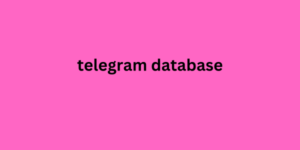Customers churn, bills and expenses don’t. If you want your business to grow, you need to make sure that new leads that turn into paying customers come in regularly.
The solution? A lead generation funnel.
Keep reading to learn everything there is to telegram database lead generation funnels and how you can build one yourself.

Note: Throughout the process, we’ll be using the GetResponse Conversion Funnel. Don’t worry, though. The tips and tactics provided in this post will prove helpful even if you’re building your lead generation funnel using any other tool.
Bonus: Get our free guide and learn how to scale your online business with conversion funnels.
Let’s start with some theories regarding lead generation.
1. What is a lead?
A lead is someone who’s shown interest in your offer and handed you their contact details, so that you can continue the conversation.
The tricky part?
The tricky part? A lead could be someone who came up to you at an event, asked you about your product, and gave you their business card to schedule a product demo.
At the same time, a lead could be someone who’s downloaded one of your ebooks in exchange for which they’ve had to leave their email address.
In the first scenario, we’ve got someone who’s clearly interested in your product and wants to learn more. In the second one, unless we know the topic of the ebook, we can’t say the same for sure.
Difference between lead quality vs lead quantity.
2. What does lead quality mean?
To distinguish good leads from bad ones, marketers and sales teams use the term lead quality.
But this concept isn’t as straightforward as it may sound. What makes a lead ‘good’ often varies between companies and could even be different for various departments within the same organization.
That’s why organizations often distinguish three kinds of leads – marketing-qualified leads, sales-qualified leads, and sales-accepted leads.
MQL (Marketing Qualified Lead): This is a lead that has been deemed qualified by the marketing team based on specific criteria. These criteria are typically set by the marketing and sales teams together, and they aim to identify leads who have shown a certain level of interest or engagement with the company’s marketing efforts. (e.g., they registered for a webinar) MQLs are typically at the top of the sales funnel, indicating that they may be more likely to become customers with further nurturing and engagement.
The criteria for determining MQLs may vary depending on the company and its target market. It can include factors such as lead demographics, engagement with marketing content, website interactions, email open rates, or other measurable indicators of interest. Once a lead meets these criteria, they are passed on to the sales team for further qualification and conversion into an SQL.
SQL (Sales Qualified Lead): This is a lead that has been further qualified and deemed ready for direct engagement by the sales team. SQLs are leads that have shown a higher level of interest and engagement compared to MQLs (e.g., they booked a demo of your product), and they are considered more likely to convert into paying customers. The sales team evaluates SQLs based on additional criteria beyond what the marketing team assessed.
The criteria for qualifying an SQL can include factors such as a specific budget, a clear need or pain point, the decision-making power within the organization, or a defined timeline for making a purchase. SQLs are considered closer to the bottom of the sales funnel, indicating that they are more likely to be actively considering a purchase or engaging in a sales conversation.
SAL (Sales Accepted Lead): This is a lead that the sales team has accepted and agreed to engage with, but it has not yet met the criteria to be classified as an SQL. SALs are leads that the sales team believes have potential, but further qualification or nurturing is required before they can be considered sales-ready. SALs are often handed off to the sales team by the marketing team or through an internal lead management process.
If you’re going to run lead generation campaigns for your company, you’ll want to make sure that you and your teammates are using the same definitions. This will make your life so much easier when reporting on your campaigns’ outcomes.
Alright, now let’s focus on how you can acquire more customers with lead generation funnels.
How users turn into website visitors, leads, and finally customers.
3. What are lead funnels?
A lead generation funnel, a.k.a. lead funnel, is a visual representation of the stages a prospect goes through during the process of becoming a lead. It outlines the steps and interactions a potential customer goes through, from the initial awareness of a business or offering to the point of becoming a qualified lead.
Lead generation funnels, similar to sales funnels, are a subset of the umbrella term called marketing funnels. The difference between a sales funnel and a lead generation funnel is that the latter doesn’t aim to make a sale (not right away, at least)
Side note: Lead funnels are also often called lead generation funnels or acquisition funnels.
